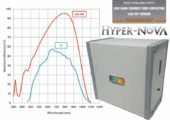Oleksandr Stroyuk, Oleksandra Raievska, Paz Sebastia-Luna, Bas A. H. Huisman, Christian Kupfer, Anastasia Barabash, Jens Hauch, Henk J. Bolink, and Christoph J. Brabec
Published: 19 January 2023 | Published by the American Chemical Society

Abstract
Thermal deposition of halide perovskites as a universal and scalable route to transparent thin films becomes highly challenging in the case of lead-free double perovskites, requiring the evaporation dynamics of multiple metal halide sources to be balanced or a single-phase precursor preliminary synthesized to achieve a reliable control over the composition and the phase of the final films. In the present Letter, the feasibility of the single-source vacuum deposition of microcrystalline Cs2AgxNa1–xBiyIn1–yCl6 double perovskites into corresponding transparent nanocrystalline films while preserving the bulk spectral and structural properties is shown. The perovskite films produced from the most emissive powders with x = 0.40 and y = 0.01 revealed a photoluminescence quantum yield of 85%, highlighting thermal evaporation as a promising approach to functional perovskite-based optical materials.
Figure 2. (a) Raman spectra of CANBIC powders (dashed lines 1p–4p) and films (solid lines 1f–4f) with y = 0.01 (1), 0.50 (2), 0.90 (3), and 1.00 (4). Spectra are shifted along Y-axis for better visibility. (b) LO phonon frequency of CANBIC powders (squares) and films (circles) as a function of Bi fraction y. The gray solid line represents a calibration curve for the determination of CANBIC composition from Raman spectra reported in ref (17).
… Reflectance spectra of CANBIC powders and absorption spectra of CANBIC films were recorded using a BlackComet spectrometer (StellarNet) and a 75 W xenon lamp (Thorlabs) as an excitation source. Absorption spectra of powders were calculated by dividing the reflectance spectra of the reference and the sample (Spectrolon, StellarNet) and subtracting a baseline …






